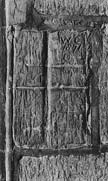Select a site alphabetically from the choices shown in the box below. Alternatively, browse sculptural examples using the Forward/Back buttons.
Chapters for this volume, along with copies of original in-text images, are available here.
Object type: Part of grave-marker(?)
Measurements: L. 27 cm (10.6 in) W. 18 cm (7.1 in) D. Built in
Stone type: [Barnack Rag type, Upper Lincolnshire Limestone, Inferior Oolite Group]
Plate numbers in printed volume: Ill. 175
Corpus volume reference: Vol 5 p. 170
(There may be more views or larger images available for this item. Click on the thumbnail image to view.)
This appears to be part of a rectangular grave-marker decorated with incised lines on its only visible face.
A (broad): There is a border defined by a fillet of rectangular section around the two surviving original edges. The central field was probably filled with a plain cross with rectangular arms defined by a pair of deeply incised lines. However only one arm of the potential cross survives. There is a second incised line across the cross-arm dividing the field up into a series of rectangular panels.
This stone appears to come from a 'gridded' marker similar to the more complete examples at Ancaster (Ill. 10), Bicker (no. 4, Ills. 49–52), Swarby (Ills. 356–7) and Wilsford (no. 2, Ills. 390–1) (see Chapter V and Table 7C). The stone type suggests that this is one of the group produced in the Barnack vicinity rather than the group around Ancaster, although both quarry sources would have been easily accessible through the Fenland river system. It is suggested above that this group of markers should be dated to the late tenth or eleventh century.



